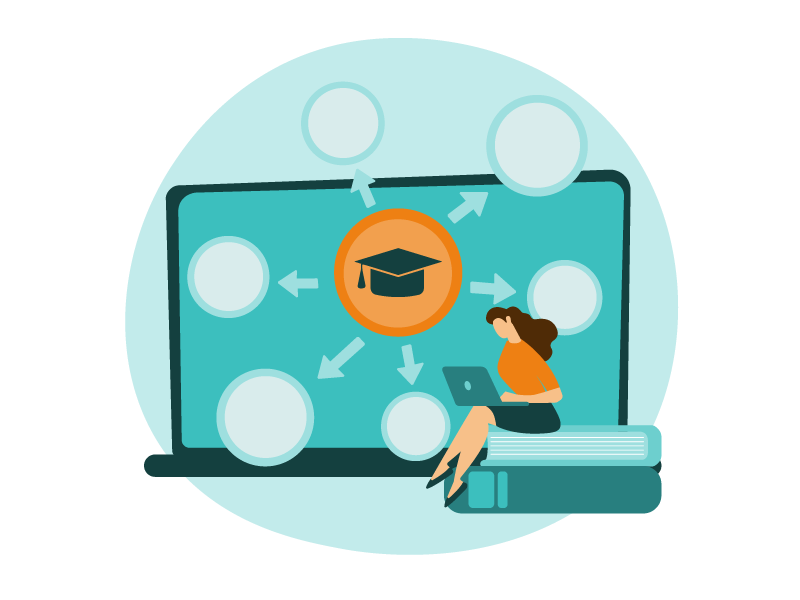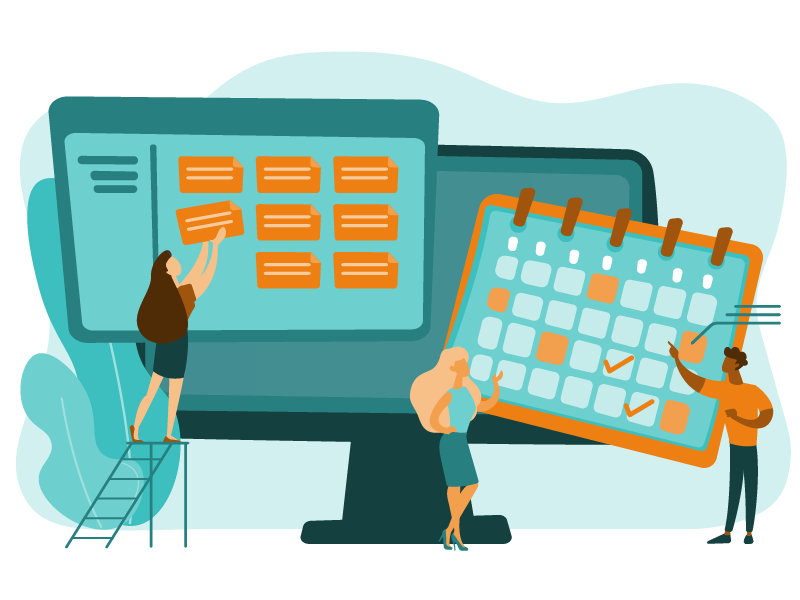Teaching and learning support for teachers
Teaching and learning support - for teachers
Teaching and learning support for teachers
Currently
Corona restrictions at NTNU: A lot of teaching activities at NTNU are taking place online.
See topic page about online teaching
What is teaching and learning support?
Teaching and learning support is help to

- choose appropriate forms of assessment and feedback
- choose teaching and learning activities that help students achieve the course’s aims
- create good teaching and learning resources
- support you in choosing and using appropriate technology
Here's how to get help
You can get help in several ways:
- You can be pointed towards good resources that you can use on your own
- You can get support and help from NTNU's staff
In the other tabs you will find more information and services about teaching and learning at NTNU.
Teaching framework
What shapes your teaching?
As a teacher, you often have to work within a framework that shapes both the planning and implementation of your teaching.

Here is an example of a framework and some reflection points around these framing factors.
- National Corona restrictions:
- The Corona Pandemic (2019–): A large part of the teaching at NTNU will take place online, we have gathered all information about the implementation of this and how you can maintain the best possible quality of education and student satisfaction here:
- Online teaching at NTNU
- Other resources:
- Quality in online teaching - a guide, Flexible education Norway (2017) (only in Norwegian)
- The Corona Pandemic (2019–): A large part of the teaching at NTNU will take place online, we have gathered all information about the implementation of this and how you can maintain the best possible quality of education and student satisfaction here:
- The nature of the subject
- The nature of the subject being taught and the learning outcome descriptions given by the study program will be provide a set of guidelines for you. The same applies to the teaching traditions at your department. However, there are many ways to design and implementation your teaching.
- NTNU has several forums where you can get inspiration across study programmes and institutes:
- The online forum NTNU Learning community
- The teaching and learning conference “Læringsfestivalen” and the regular experience sharing seminars “Læringstreff” (both in Norwegian only)
- The students
- What year are the students in the course? There may be different needs for first-year students versus last-year students in terms of follow-up needs and access to support and a teacher.
- Teaching facilities
- Where will the teaching take place - in one or more campus cities? How will you ensure equal teaching?
- What physical teaching areas and rooms do you have available, and how can you best facilitate learning in these despite differences in design and available equipment?
- What technology do you have at your disposal? When should it be used and how can it be used appropriately?
- Time / resources
- How much time are you able to spend planning and then teaching? Sometimes a large one-time effort can improve and simplify later teaching courses.
- Do you have access to teaching assistants? Teaching assistants can be a versatile and useful resource to include in the design of teaching. Maybe they can participate in other tasks than you first thought?
- Can you collaborate more with your colleagues? This can both save time and increase motivation.
- Change your teaching framework?
Do you have ideas or issues related to your teaching framework that you want to discuss?
Feel free to contact the Section for Teaching and Learning Support to discuss these:
- NTNU Hjelp: message us for support. Remember to mark your query with SLS or our name, Section for teaching and learning support
You can also apply for support and funds for development:
- Development projects via NTNU Top Education
- Programs and grants via Diku
- Local announcements at your faculty/institution
You can also discuss with your colleagues:
Teaching design
 Good teaching can, among other things, be characterized as having a good correspondence between the learning goals, learning activities and assessment, so-called constructive alignment. This means that you should choose learning activities and forms of assessment that support the learning objectives in the best possible way.
Good teaching can, among other things, be characterized as having a good correspondence between the learning goals, learning activities and assessment, so-called constructive alignment. This means that you should choose learning activities and forms of assessment that support the learning objectives in the best possible way.
Here is an overview of what choices you have at NTNU, and some good tips to think about when designing teaching.
Selecting teaching learning activities
Which teaching learning activities can be good to use in your subject to help the students to achieve the learning goals in the best possible way? And how can these be well organized during the course to ensure learning and progression?
Teaching and learning activities can be:
- Physically in-person and/or digital
- Teaching and learning activities can be both in-person or digital, and often a combination of the two. It is a good idea to think about which activities are suitable in-person or digital, especially with regard to relationship building. Digital teaching and learning activities can, among other things, provide students with useful digital skills for the future.
- Asynchronous (not in real-time) and synchronous (in real-time)
- Asynchronous teaching and learning activities are activities that don’t take place at the same time for all participants. They’re activities where the students can participate when they want, within a timeframe. An example of an activity that could be asynchronous is learning about theories or discussing via a digital conversation thread with fellow students. Synchronous activities, on the other hand, take place in real time. This can be, among other things, streamed lectures and webinars.
Teaching and learning activities can vary between the following:
- Individual work
- Students work with individual work, for example through the acquisition of theory (text, video, nano-courses), reflection (notes, blog), repetition (quiz).
- Useful to strengthen digital competence.
- Cooperative work
- Students work, discuss and reflect together, for example through group discussions, group assignments, collaborative writing, fellow student assessment, Team-based learning (TBL).
- Useful for training communication and collaboration skills.
- Plenary work
- Students or lecturers present material in plenary, for example via lectures, podcasts, videos or student presentations.
- Often good for creating a sense of community and practicing communication skills.
- Skills training
- Students get skills training to practice what they have learned, for example through lab work, simulations, role play, field work and internships.
- Often provides useful insights and equips students for working life.
- Community
- Learning that takes place in informal arenas, for example in mingling areas, restaurants, digital meeting places or on training trips.
- NOTE: as a lecturer, you cannot require students to meet in digital arenas where NTNU does not have a data processor agreement.
Other issues to consider are the choice of teaching and learning arenas and the use of learning resources, more on this in the next two tabs.
Choosing assessment methods

What forms of assessment will be useful for your students? Assessment forms should be in alignmented with the learning activities that have been used.
A good guide when creating assessment that enhances learning goals and outcomes is Bloom's taxonomy, a hierarchical classification of the different levels of knowledge in the learning process:
Varying assessment forms?
In the parliamentary rapport Mld.st. 16 (2016–2017), guidelines require that students have varied forms of assessment, this is also recommended in NOKUT's Quality Areas for study programs (.pdf) (in Norwegian only). This states that to stimulate in-depth learning and to help students achieve the expected learning outcome a wide variety of assessment is beneficial. Read more about assessment at NOKUT:
- Assessment and exam (in Norwegian only)
Guidelines and practical support for exams at NTNU during the Corona period:
Help and support
Do you have ideas or issues with teaching design that you want to discuss?
Feel free to contact the Section for Teaching and Learning Support to discuss these:
- NTNU Hjelp: message us for support. Remember to mark your query with SLS or our name, Section for teaching and learning support
- Digital Open Office for teaching and learning support
You can also discuss with your colleagues:
Teaching and learning facilities
 The teaching and learning spaces you have access to have an impact on which teaching and learning activities you can carry out. At NTNU, we get an ever-increasing selection of different facilities, both digital and physical.
The teaching and learning spaces you have access to have an impact on which teaching and learning activities you can carry out. At NTNU, we get an ever-increasing selection of different facilities, both digital and physical.
Here is an overview of the teaching and learning facilities at NTNU and how you can use them well in your teaching.
Digital teaching and learning facilities
These are NTNU's recommended digital learning spaces:
- Blackboard - NTNU's learning management system
- Blackboard Collaborate Ultra
- Zoom video tutorial
Tips for good online teaching and learning environments:
- Recommended practice for online sessions
- Hybrid teaching
- Interaction and collaboration in online sessions
- How to create a good learning environment in digital teaching? (in Norwegian only)
Physical teaching and learning facilities
This is an overview of NTNU's on-campus physical teaching and learning spaces:
- Physical teaching and learning facilities at NTNU (coming)
Tips for creating a good learning environment in physical teaching and learning facilities:
Learning resources and tools
Do you want to create good teaching and learning resources?
 You can get advice and guidance to help produce teaching and learning resources on your own, or you can get help to produce larger amounts of resources together with the Section for learning support.
You can get advice and guidance to help produce teaching and learning resources on your own, or you can get help to produce larger amounts of resources together with the Section for learning support.
Direct links to different types of learning resources:
- Video in teaching (in Norwegian only)
- Podcast in teaching
- Interactive learning resources, H5P (in Norwegian only)
- Universal design of digital learning resources
Topic page: Producing teaching and learning resources (coming)
NTNU has several good tools and services for the production of teaching and learning resources.
Direct links to digital tools:
- Blackboard
- Panopto teaching admissions
- Zoom video tutorial
- Mentimeter student response system
- Padlet
- H5P interactive video (in Norwegian only)
Topic page: Digital learning tools (coming)
Sharing your experiences
It can be helpful and rewarding to discuss teaching with like-minded people.
- NTNU Læringsfestivalen (in Norwegian only) is an annual national conference for the higher education sector, arranged at NTNU Trondheim in May.
- Læringstreff (in Norwegian only) is a series of meetings and sessions for NTNU employees on various topics within learning and teaching.
- NTNU Learning Community is an online forum where employees at NTNU can discuss different topics within learning and teaching.
National and international courses and events (currently only in Norwegian)
Contact and support
Do you have questions or need help? Maybe you have a new tool you want to test?
Get support through NTNU Hjelp.
